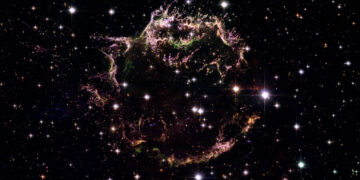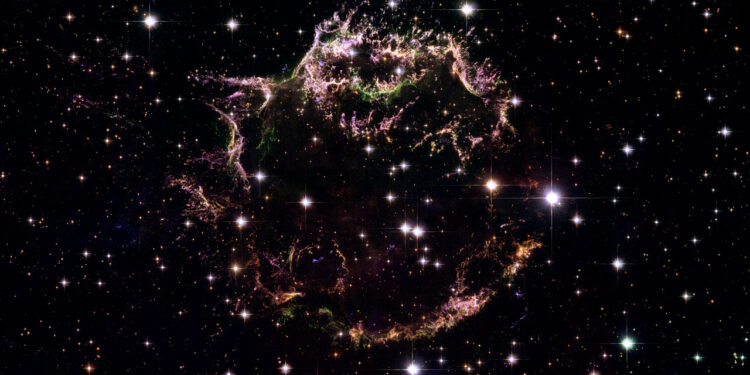The James Webb Space Telescope (JWST) has delivered yet another breathtaking glimpse into the universe, this time through the lens of light echoes—an awe-inspiring phenomenon that captures the reverberations of a star’s death. Observing the aftermath of a massive stellar explosion near Cassiopeia A, JWST has uncovered intricate details of the interstellar medium, mapping it in 3D for the first time.
What Are Light Echoes and Why Do They Matter?
Imagine a stone dropped into a still pond. The ripples that extend outward are akin to light echoes in space—waves of light emitted during a star’s final, dramatic collapse. When a massive star explodes as a supernova, it generates an intense burst of energy and light, which then travels through surrounding interstellar gas and dust.
As the light interacts with this material, it heats the gas and dust, causing it to glow and form a visible “echo.” These echoes expand in complex patterns, much like ripples on water, offering a time-lapsed glimpse into the aftermath of stellar death.
The light echoes near Cassiopeia A have allowed scientists to observe how the interstellar medium—composed of gas, dust, and magnetic fields—responds to such violent cosmic events.
The Discovery at Cassiopeia A
Cassiopeia A, a well-known supernova remnant located approximately 11,000 light-years away, has long been a focus of scientific curiosity. Decades ago, a massive star in this region underwent a catastrophic collapse, sending shockwaves and light rippling through space.
JWST’s Near-Infrared Camera (NIRCam) has captured these light echoes with stunning precision, documenting their rapid expansion over a matter of weeks—a relatively short time for observing cosmic phenomena.
What sets this discovery apart is the level of detail in the images. Dense filaments, resembling tightly packed sheets of gas and dust, appear on scales of about 400 astronomical units, a level of precision never before achieved. According to Josh Peek of the Space Telescope Science Institute, these structures could be influenced by interstellar magnetic fields, adding a new layer of complexity to our understanding of the interstellar medium.
Mapping the Universe in 3D
One of the most transformative aspects of this discovery is the 3D mapping of the interstellar medium. JWST’s observations have been likened to a cosmic CT scan, offering a layered view of the gas and dust surrounding Cassiopeia A.
By capturing light echoes at three distinct time intervals, scientists were able to reconstruct the spatial distribution of interstellar material. This achievement is a first in astronomy, marking a significant leap in our ability to study the universe’s structure.
Armin Rest, an astronomer at the Space Telescope Science Institute, explained the significance of this development: “This is the astronomical equivalent of a medical CT scan. It will completely change the way we study the interstellar medium.”
The Science Behind JWST’s Breakthrough
JWST’s unprecedented capabilities in infrared imaging are at the heart of this discovery. Infrared light can penetrate dense clouds of gas and dust, revealing structures hidden to telescopes that rely on visible light.
The telescope’s Near-Infrared Camera (NIRCam) captured the light echoes in extraordinary detail, while its Mid-Infrared Instrument (MIRI) will soon conduct spectroscopic studies of the illuminated dust. This combination allows scientists to analyze changes in the composition and states of molecules within the interstellar medium.
A Window into the Early Universe
The discovery of light echoes also provides a rare opportunity to study the dynamics of supernovae and their effects on the surrounding environment. Supernova explosions play a crucial role in the cosmos, dispersing heavy elements like carbon, oxygen, and iron into space. These elements are the building blocks of planets, stars, and life itself.
Why This Discovery is Revolutionary
This discovery is a testament to the power of modern technology and international collaboration. It stands out for several reasons:
- Unprecedented Detail: The images captured by JWST reveal structures within the interstellar medium that were previously invisible, offering a new perspective on cosmic phenomena.
- Real-Time Observation: Observing the rapid expansion of light echoes over weeks provides dynamic insights into the aftermath of supernovae.
- Transformative Techniques: The ability to map the interstellar medium in 3D represents a significant advancement in astronomical methods.
The Lasting Legacy of Webb
As NASA Administrator Bill Nelson aptly noted, “Even as a star dies, its light endures—echoing across the cosmos.” JWST has not only captured the light echoes of a dying star but also illuminated the path for future discoveries.
This milestone serves as a reminder of the beauty and complexity of the universe and the power of human ingenuity in unraveling its mysteries. The telescope’s findings inspire awe and curiosity, encouraging us to continue exploring the cosmos and seeking answers to the questions that define our existence.
Conclusion
The James Webb Space Telescope’s observations of light echoes near Cassiopeia A represent a monumental leap in our understanding of the universe. By uncovering the intricate details of the interstellar medium and mapping it in 3D, JWST has transformed how we study stellar death and its impact on the cosmos.



















